
Brunei, formally Brunei Darussalam, is a country in Southeast Asia, situated on the northern coast of the island of Borneo. Apart from its coastline on the South China Sea, it is completely surrounded by the Malaysian state of Sarawak, with its territory bifurcated by the Sarawak district of Limbang. Brunei is the only sovereign state entirely on Borneo; the remainder of the island is divided between Malaysia and Indonesia. As of 2020 the country had a population of 460,345, of whom approximately 100,000 resided in the capital and largest city Bandar Seri Begawan. The government of Brunei is an absolute monarchy ruled by the Sultan of Brunei, and it implements a fusion of English common law and jurisprudence inspired by Islam, including sharia.
Brunei joined ASEAN on 7 January 1984, one week after resuming full independence, and gives its ASEAN membership the highest priority in its foreign relations. Brunei joined the United Nations in September 1984. It is also a member of the Organisation of Islamic Cooperation (OIC), the Asia-Pacific Economic Cooperation (APEC) forum and the Commonwealth of Nations. Brunei hosted the APEC Economic Leaders' Meeting in November 2000. In 2005 it attended the inaugural East Asia Summit.
The history of Brunei concerns the settlements and societies located on the north coast of the island of Borneo, which has been under the influence of Indianised kingdoms and empires for much of its history. Local scholars assume that the Islamisation of Brunei started in the fifteenth century, with the formation of the Bruneian Empire, a thalassocracy which covered the northern part of Borneo and the southern Philippines. At the end of the 17th century, Brunei subsequently entered a period of decline brought on by Brunei Civil War, piracy, and European colonial expansion. Later, there was a brief war with Spain, in which Brunei lost Manila and evacuated their capital for a brief period until the Spanish withdrew. The empire lost much of its territory with the arrival of the Western powers, such as the Spanish in the Philippines and the British in Labuan, Sarawak, and North Borneo. The decline of the Bruneian Empire accelerated in the nineteenth century when Brunei gave much of its territory to the White Rajahs of Sarawak, resulting in its current small landmass and separation into two parts. Sultan Hashim Jalilul Alam Aqamaddin later appealed to the British to stop further annexation in 1888. In the same year, the British signed a "Treaty of Protection" and made Brunei a British protectorate until 1984 when it gained independence and prospered due to the discovery of oil.

Bandar Seri Begawan is the capital and largest city of Brunei. It is officially a municipal area with an area of 100.36 square kilometres (38.75 sq mi) and an estimated population of 100,700 as of 2007. It is part of Brunei-Muara District, the smallest yet most populous district which is home to over 70 per cent of the country's population. It is the country's largest urban centre and nominally the country's only city. The capital is home to Brunei's seat of government, as well as a commercial and cultural centre. It was formerly known as Brunei Town until it was renamed in 1970 in honour of Sultan Omar Ali Saifuddien III, the 28th Sultan of Brunei and the father of the current Sultan Hassanal Bolkiah.
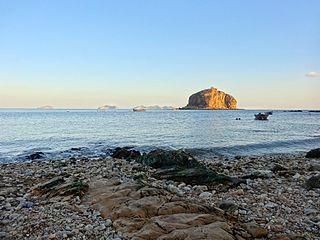
An islet is a very small, often unnamed island. Most definitions are not precise, but some suggest that an islet has little or no vegetation and cannot support human habitation. It may be made of rock, sand and/or hard coral; may be permanent or tidal ; and may exist in the sea, lakes, rivers or any other sizeable bodies of water.
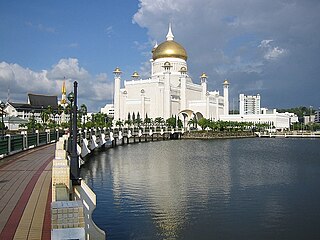
Brunei-Muara District or simply Brunei-Muara is one of the four districts of Brunei. It has the smallest area among the four districts, with 571 square kilometres (220 sq mi), yet is the most populous, with 289,630 people as of 2016. Bandar Seri Begawan, the country's capital, is located in this district, which is also de facto the district's capital. It is also home to Brunei International Airport, the country's only international airport, as well as Muara Port, the main and only deep-water port in the country. The Brunei River flows within this district and is home to Kampong Ayer, the traditional historic settlement on stilts above the river.
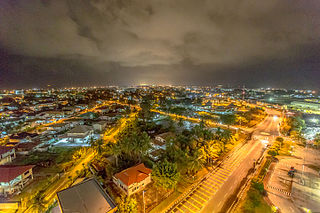
Kuala Belait is the administrative town of Belait District, Brunei. The population of the town proper was 4,259 in 2016. Kuala Belait is officially a municipal area, as well as a village under the mukim of the same name. The town is located 85 kilometres (53 mi) west of the country's capital Bandar Seri Begawan, and 20 kilometres (12 mi) west of Seria, the district's other town. It is also in the westernmost part of country, near the mouth of the Belait River.
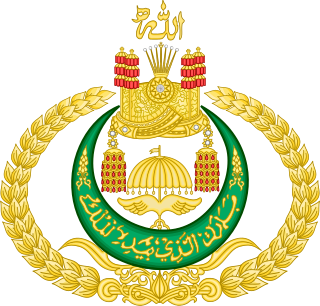
The prime minister of Brunei is the head of government of Brunei. Concurrently, the title is held by the sultan of Brunei, who as sultan is also the head of state of the country. As the prime minister, the Sultan and Yang Di-Pertuan is the head of both the ministerial cabinet and the Legislative Council of Brunei.
The administrative divisions of Brunei mainly consist of daerah (districts), mukim (subdistricts) and kampung or kampong (villages). They are organised hierarchically, with daerah being the first level and kampong the third level.

There are a number of languages spoken in Brunei. The official language of the state of Brunei is Standard Malay, the same Malaccan dialect that is the basis for the standards in Malaysia and Indonesia. This came into force on 29 September 1959, with the signing of Brunei 1959 Constitution.

The Sultanate of Brunei or simply Brunei was a Malay sultanate, centred in Brunei on the northern coast of Borneo island in Southeast Asia. Brunei became a sovereign state around the 15th century, when it grew substantially after the fall of Malacca to the Portuguese, extending throughout coastal areas of Borneo and the Philippines, before it declined in the 17th and 18th centuries. The first ruler or sultan of Brunei was a Muslim. It became a British protectorate in the 19th century.

Bruneian Malays are a native Malay ethnic group that lives in Brunei, the federal territory of Labuan, the southwestern coast of Sabah and the northern parts of Sarawak. The Bruneian Malays are a subgroup of the larger ethnic Malay population found in the other parts of the Malay World, namely Peninsular Malaysia and the central and southern areas of Sarawak including neighbouring lands such as Singapore, Indonesia and Southern Thailand, having visible differences especially in language and culture, even though they are ethnically related to each other and follow the teachings of Islam. All Bruneian Malays who are born or domiciled in East Malaysia even for generations before or after the independence of the states of Sabah and Sarawak from the British Empire through the formation of Malaysia in 1963 are also considered Malaysian Malays in the national census and were in the same status like the Malaysian Malays domiciled in Peninsular Malaysian states and the central and southern parts of Sarawak. They are also defined as a part of the Bumiputera racial classification together as a subgroup within the Malaysian Malay ethnic population along with the Kadazan-Dusuns, Orang Ulu, Ibans, Malaccan Portuguese, Muruts, Orang Sungai, Bajau, Suluks and the Malaysian Siamese.
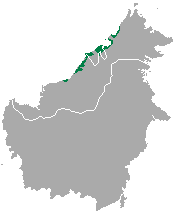
The Brunei Malay language is the most widely spoken language in Brunei and a lingua franca in some parts of Sarawak and Sabah, such as Labuan, Limbang, Lawas, Sipitang and Papar. Though Standard Malay is promoted as the official national language of Brunei, Brunei Malay is socially dominant and it is currently replacing the minority languages of Brunei, including the Dusun and Tutong languages. It is quite divergent from Standard Malay to the point where it is almost mutually unintelligible with it.

Tabuan Island is an island of southern Sumatra, under the jurisdiction of Lampung province. It is administered as part of the Cukuh Balak district of Tanggamus Regency.
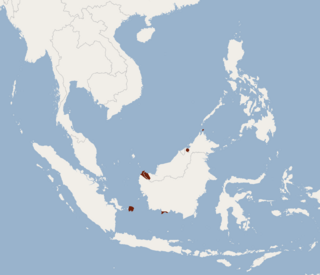
The Vordermann's pipistrelle is a species of vesper bat found in Brunei Darussalam, Indonesia, and Malaysia. It was described in 1890 by the Dutch zoologist Fredericus Anna Jentink, who named it after its discoverer, the Dutch physician Adolphe Vorderman.

The Kuala Belait Port, also known as Kuala Belait Wharf, is a port operated by both the Brunei Shell Petroleum (BSP) and Maritime and Port Authority Brunei Darussalam (MPABD). The port can only accommodate low-draught ships. It is one of the only three existing ports in the country.

Selirong Island, also known as Mosquito Island, is an island located within the Brunei Bay and Mukim Labu, Temburong District, Brunei. The island also sits at the river delta of the Temburong River.

Cermin Island is an islet at the mouth of Brunei River in the Mukim Kota Batu, Brunei-Muara District, Brunei. During the Brunei Civil War, a battle unfolded on the island and it's sometimes referred to as the Peperangan Pulau Cermin. A proposal for an 5 hectares protection status to be implemented on the island. The island is home to sundry vegetation and swamp forests.

Berambang Island is an island at the southern bank of the Brunei River in the Mukim Kota Batu, Brunei-Muara District, Brunei. The island was formerly named Buang Tawer during The Brooke Era from 1841 until 1941. The mausoleum of the 9th Sultan of Brunei, Sultan Muhammad Hassan is located on the island, near Kampong Sungai Bunga.

















